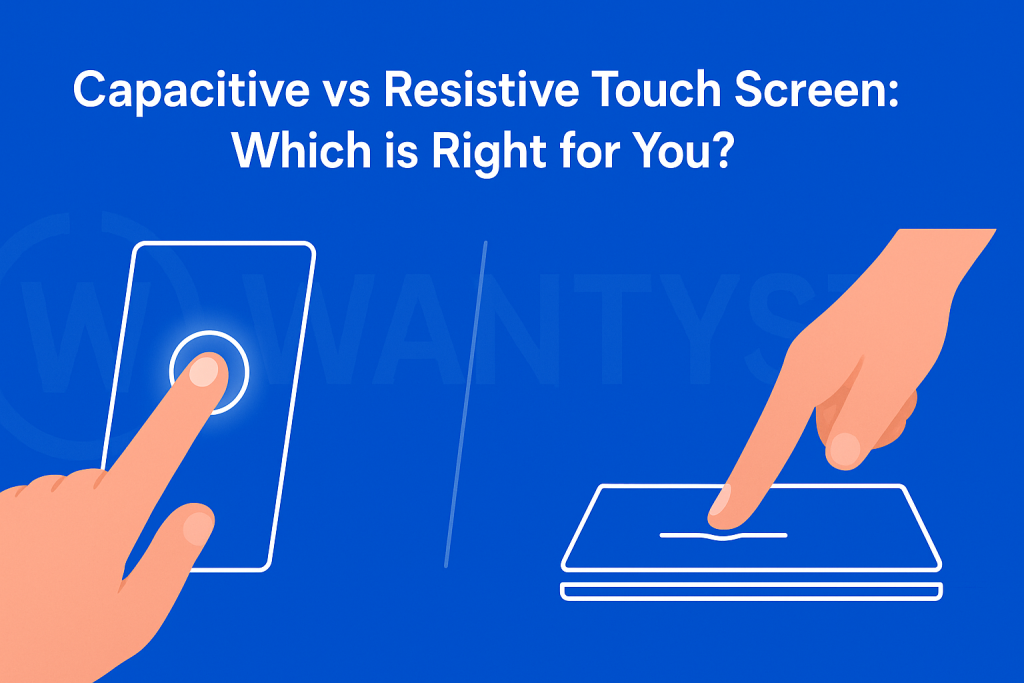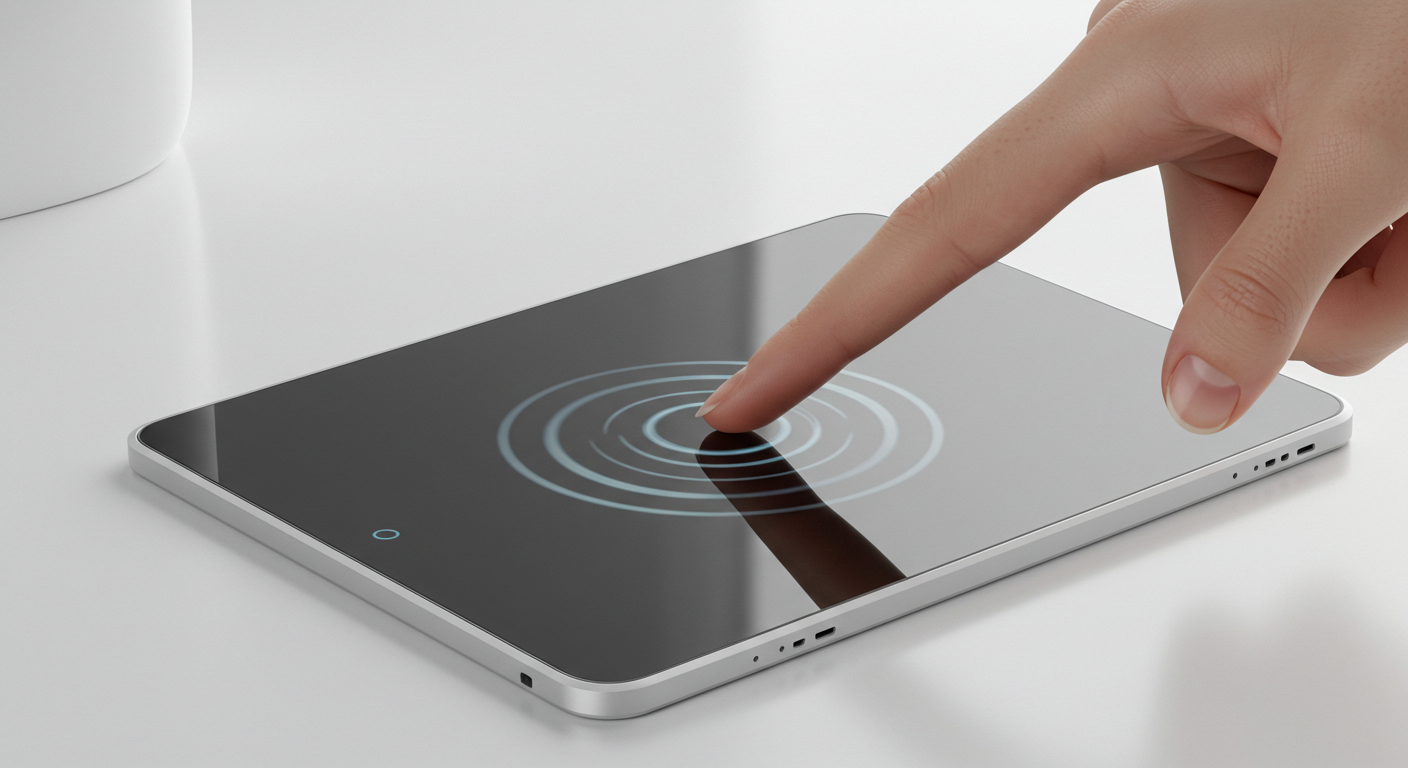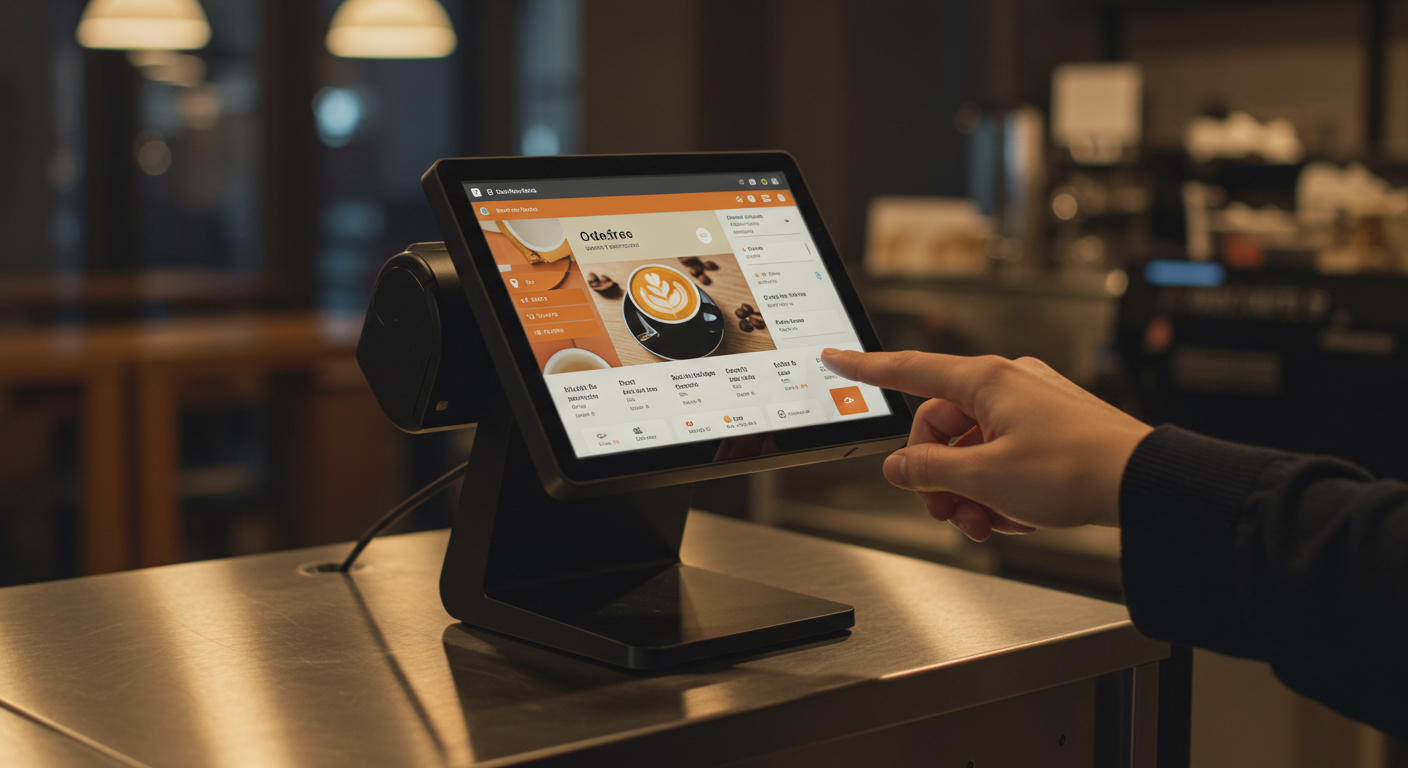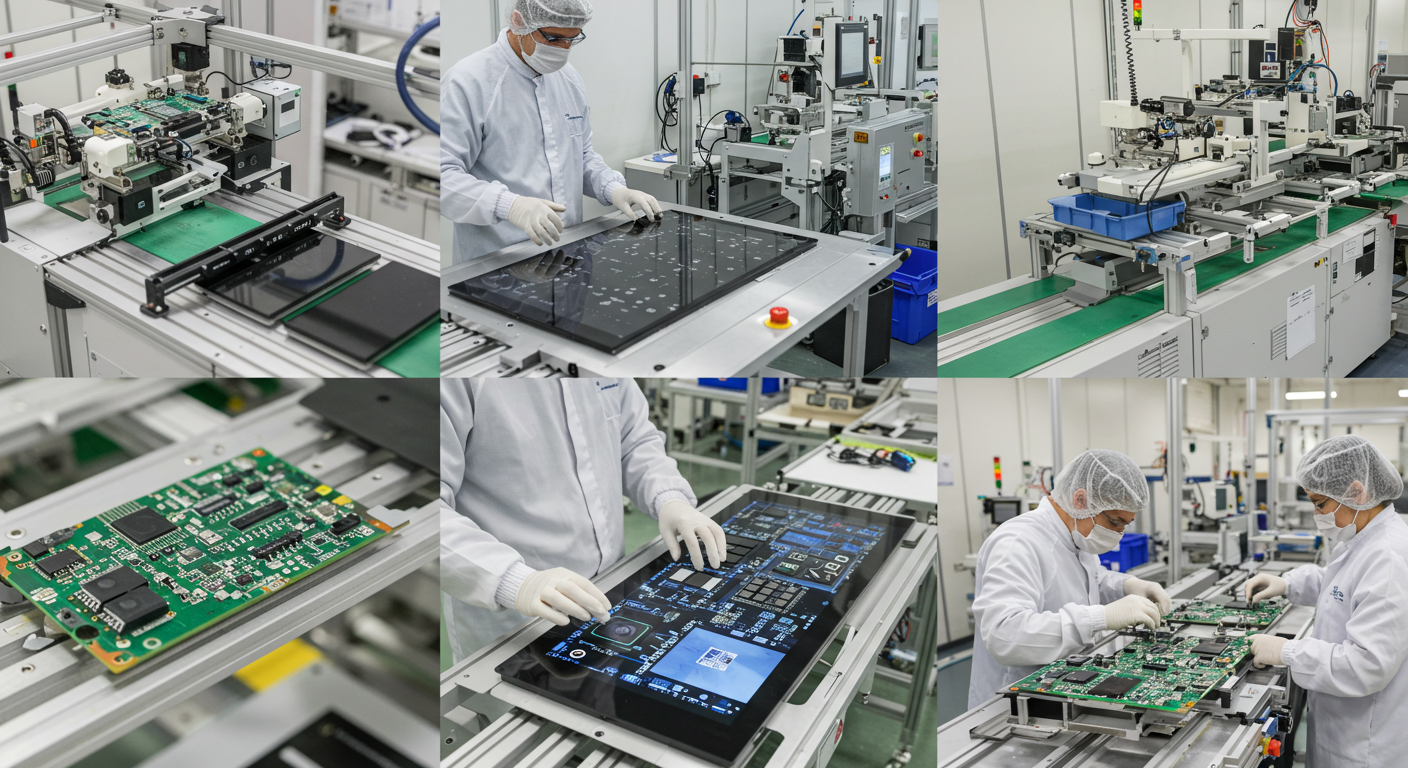Capacitive vs Resistive Touch Screen: Which is Right for You?
News
Jun-22-2025

Ever tried using your smartphone with gloves on and it just wouldn’t respond? Or maybe you’ve tapped an ATM screen that needed a firm press to work? That’s the difference between capacitive touchscreens and resistive touchscreens. These two types of touchscreen technology power most of the devices we use, but they work in totally different ways and suit different needs. In this guide, we’ll break down capacitive vs resistive touch screen technology in a simple, beginner-friendly way. We’ll cover how they work, their pros and cons, and where they’re used, so you can decide which is best for your device or project. Let’s get started!
What is a Capacitive Touch Screen?
A capacitive touchscreen detects your touch using electrical charges. It senses the tiny electrical signals from your finger or a special stylus, making it super responsive. You don’t need to press hard—a light tap or swipe is enough. This is why your phone feels so smooth when you scroll through apps or zoom in on a photo.
These screens are the go-to for smartphones, tablets, and sleek devices because they’re fast and support multi-touch gestures like pinching or rotating. To dive deeper into the basics, check out What is a capacitive touch screen for a full explanation of this technology.
Why Capacitive Screens Are Popular
Capacitive touchscreens dominate consumer devices thanks to their speed and versatility. They rely on conductive input, like your finger, which makes them precise but sometimes tricky with gloves or non-conductive objects.
Key Components
The main parts of a capacitive screen include a glass surface, a conductive layer (usually indium tin oxide), and sensors that detect changes in the electric field. These components work together to make your interactions feel instant and natural.
What is a Resistive Touch Screen?
A resistive touchscreen works by detecting pressure. It has two flexible layers separated by a tiny gap. When you press down, the layers touch, completing an electrical circuit that tells the device where you pressed. You can use your finger, a stylus, or even a gloved hand—anything that applies pressure works.
Resistive screens are less sensitive than capacitive ones and don’t handle multi-touch well. But they’re tough and shine in rugged environments like factories or outdoor kiosks. They’re also stylus-friendly, perfect for tasks like signing your name on a delivery tablet.
How Resistive Screens Stand Out
Resistive touchscreens are all about durability and flexibility. They don’t need conductive input, so they’re ideal for settings where users wear gloves or need to use any object as a stylus.
Common Components
Resistive screens use flexible layers, often made of polyester, coated with conductive materials. These layers are durable but can wear out with heavy use over time.
How Capacitive Touch Screens Work
Capacitive touchscreens are like a high-tech sandwich: a glass surface, a conductive layer (usually indium tin oxide, or ITO), and a protective top layer. The conductive layer creates a constant electric field across the screen. When your finger touches it, it disrupts that field because your body is a conductor. Sensors detect this change and pinpoint exactly where you touched.
Picture a calm pond. Your finger is a pebble that creates ripples, and the screen “sees” those ripples to know where you touched. This happens in milliseconds, so it feels instant. For a detailed breakdown, read How capacitive touch screens work.
Role of Electrodes
Capacitive screens use a grid of electrodes to track your touch. This grid forms a coordinate system that maps your finger’s position with pinpoint accuracy, enabling multi-touch gestures like zooming or rotating.
Why It’s So Responsive
The electric field design means capacitive screens detect even the lightest touch. There’s no lag, making them perfect for fast-paced tasks like gaming or typing.
Basic Working of Resistive Touch Screens
Resistive touchscreens have two thin, flexible layers separated by a small gap. When you press down, the layers touch, creating a circuit that tells the device where you pressed. It’s like pressing two sheets of plastic together to make a connection.
This pressure-sensitive screen doesn’t care what touches it—your finger, a stylus, or a gloved hand works fine. But it needs a bit of force, so it’s less responsive than capacitive screens. It also struggles with multi-touch, usually handling only one touch at a time.
Pressure-Based Detection
The key to resistive screens is pressure. The harder you press, the better the connection, which makes them reliable for simple inputs but slower for complex tasks.
Limitations in Speed
Because they rely on physical contact, resistive screens can feel clunky compared to capacitive ones. The need for pressure slows down the response time, especially for rapid taps.
Comparison Table: Capacitive vs Resistive Touch Screens
Here’s a side-by-side look at the key differences between these touchscreen technologies:
| Feature | Capacitive Touchscreen | Resistive Touchscreen |
|---|---|---|
| Touch Method | Electrical charge (finger or stylus) | Pressure (any object) |
| Responsiveness | Very fast, light touch | Slower, requires pressure |
| Multi-Touch | Yes (pinch, zoom, swipe) | Rarely (usually single-touch) |
| Durability | Durable glass surface | Flexible layers, prone to wear |
| Clarity | Bright, clear visuals | Slightly dimmer due to layers |
| Glove Use | Limited (needs special gloves) | Works with any glove or stylus |
| Outdoor Use | Better in sunlight, water can interfere | Works in wet conditions |
| Cost | More expensive | Cheaper |
This table highlights why each type of touchscreen excels in different scenarios.
Touch Accuracy and Responsiveness
Capacitive touchscreens are top-notch for touch accuracy. Their electrode grid detects the exact spot where your finger touches, making them ideal for precise tasks like drawing or typing on a phone. Their responsiveness is lightning-fast, so there’s no delay when you tap or swipe, creating a seamless experience.
Resistive touchscreens are less accurate because they rely on pressure. You need to press harder, and the touch point can be slightly off, especially on worn screens. They’re slower to respond, which can feel clunky for fast tasks like gaming. But their pressure-sensitive design is reliable for simple inputs, like selecting an option on a kiosk.
Capacitive Precision
The electric field in capacitive screens allows for pinpoint accuracy, even with light touches. This is why they’re the choice for devices requiring fine control, like graphic tablets.
Resistive Trade-Offs
Resistive screens sacrifice precision for versatility. They’re great for broad inputs, like pressing buttons, but less suited for detailed tasks like sketching.
Multi-Touch vs. Single Touch
Multi-touch is a game-changer, and capacitive touchscreens lead the way. They can handle multiple touch points at once, letting you pinch to zoom, rotate images, or swipe with two fingers. This makes them perfect for modern devices that rely on complex gestures, like smartphones and tablets.
Resistive touchscreens typically stick to single-touch. They’re designed for one press at a time, like choosing an option on an ATM. Some advanced resistive screens support basic multi-touch, but it’s rare and not as smooth. If multi-touch is a must, capacitive is the clear winner.
Why Multi-Touch Matters
Multi-touch enables intuitive interactions, like zooming in on a map or playing games with multiple controls. It’s a key reason capacitive screens dominate consumer tech.
Single-Touch Simplicity
Single-touch is enough for straightforward tasks, like selecting menu options or signing a screen. Resistive screens excel in these no-frills scenarios.
Durability and Rugged Usage
Capacitive touchscreens are tough, thanks to their glass surface. They resist scratches and hold up well under heavy use, making them great for consumer devices like phones that get tapped all day. However, they can crack if dropped and aren’t always ideal for super-rugged environments.
Resistive touchscreens are built for rugged usage. Their flexible layers can handle tough conditions, like dust, heat, or extreme cold, which is why they’re common in factories or construction sites. But those layers wear out with constant pressing, so they may need replacing sooner than capacitive screens.
Capacitive Durability
The glass surface of capacitive screens is strong and scratch-resistant, but it’s not invincible. Protective cases and tempered glass help extend their life.
Resistive Toughness
Resistive screens are designed for harsh environments. Their flexibility makes them less likely to shatter, but repeated pressure can degrade the layers over time.
Outdoor Performance and Glove Use
Outdoor performance varies between the two. Capacitive touchscreens are brighter and clearer, thanks to their glass surface, which makes them easier to read in sunlight. But they struggle with water—rain or wet fingers can cause misreads. They also don’t work well with regular gloves, though some support special conductive gloves.
Resistive touchscreens are better for glove use. You can press them with any glove, stylus, or even a pen, which is great for workers in cold or industrial settings. They also handle wet conditions better, as water doesn’t interfere with pressure-based detection. However, their layered design can make them harder to read in bright sunlight.
Capacitive Outdoor Challenges
Capacitive screens shine in bright light but falter in wet conditions. Advanced designs, like Projected Capacitive Touch (PCAP), are improving their outdoor performance.
Resistive Outdoor Strengths
Resistive screens are less affected by water or gloves, making them a solid choice for outdoor kiosks or cold climates, despite their dimmer displays.
Real-World Use Cases: Consumer Devices vs Industrial
Capacitive and resistive touchscreens each have their sweet spots. Here’s where they’re commonly used:
Capacitive Touchscreen Use Cases
- Smartphones and Tablets: iPhones, Androids, and iPads rely on capacitive screens for smooth scrolling and multi-touch gestures.
- Laptops: Touchscreen laptops use capacitive tech for precise navigation and creative tasks like drawing.
- Car Infotainment: Modern cars use capacitive screens for GPS, music, and climate controls.
- Gaming Consoles: Devices like the Nintendo Switch use capacitive screens for responsive gaming.
- Smart Home Devices: Smart thermostats and hubs use capacitive screens for sleek control.
For more examples, see Capacitive touch screen use cases.
Resistive Touchscreen Use Cases
- Industrial Machines: Factories use resistive screens for control panels, often with gloved hands.
- ATMs and Kiosks: Many ATMs and ticketing machines use resistive screens for simple, reliable inputs.
- Medical Devices: Some hospital equipment uses resistive screens for stylus-based precision.
- Point-of-Sale Terminals: Older retail systems use resistive screens for durability and glove compatibility.
- Rugged Handhelds: Devices in construction or logistics use resistive screens for tough conditions.
Resistive screens thrive in settings where ruggedness and input flexibility matter more than multi-touch or speed.
Advantages of Capacitive Touch Screens
Capacitive touchscreens are the top choice for consumer devices for several reasons:
- Super Responsive: React to light touches, ideal for fast tasks like gaming or typing.
- Multi-Touch Support: Perfect for pinching, zooming, and swiping with multiple fingers.
- Clear Visuals: Glass layers create bright, vibrant displays for stunning images and videos.
- Durable Glass: Resists scratches and holds up under daily use.
- Sleek Design: Enables thinner, lighter devices for portability.
- Energy Efficient: Uses less power for touch detection, saving battery life.
Want to explore these benefits further? Check out Advantages of capacitive touch screens for a full breakdown.
Why Consumers Love Capacitive
The smooth, intuitive feel of capacitive screens makes them a favorite for phones, tablets, and other personal devices. Their vibrant displays and quick response times enhance the user experience.
Cost-Effectiveness at Scale
Capacitive screens are more expensive to produce, but their popularity and manufacturing advances have made them affordable for mass-market devices.
When Resistive Touch is Better
Resistive touchscreens shine in specific scenarios where capacitive screens fall short:
- Glove-Friendly: Works with any glove, ideal for cold weather or industrial workers.
- Stylus Versatility: Any object can press the screen, great for signatures or precise inputs.
- Rugged Environments: Handles dust, heat, and wet conditions better than capacitive screens.
- Lower Cost: Cheaper to produce, making them budget-friendly for simple devices.
- No Conductive Input Needed: Perfect for settings where users don’t have bare hands or special styluses.
Resistive screens are often found in factories, ATMs, or older kiosks where durability and input flexibility outweigh the need for multi-touch or speed.
Industrial Reliability
In harsh settings, resistive screens are a dependable choice. Their ability to work with any input device makes them versatile for workers in tough conditions.
Budget-Friendly Applications
For devices that don’t need fancy gestures or bright displays, resistive screens offer a cost-effective solution without sacrificing core functionality.
Custom Use Cases for Touchscreens
Both capacitive and resistive touchscreens can be customized for unique needs. Capacitive screens, especially, are highly adaptable. For example, Projected Capacitive Touch (PCAP) screens work through thick glass or gloves, making them great for rugged environments like outdoor kiosks or medical devices. Need a curved touchscreen for a car dashboard or a giant display for a museum? Custom capacitive screens can be tailored for size, shape, or sensitivity.
Resistive screens can also be customized, often for industrial or medical devices where precise stylus input is key. They’re less common for high-end customization but still valuable for specific applications. Need something specific? See our Capacitive touch custom screen options to explore tailored solutions.
Capacitive Customization
Capacitive screens can be designed for unique shapes, sizes, or durability needs, making them ideal for innovative consumer products or specialized industrial uses.
Resistive Customization
Resistive screens are often customized for rugged devices, like handheld scanners or medical equipment, where reliable pressure-based input is critical.
Conclusion and Recommendation
So, capacitive vs resistive touch screen—which should you choose? It depends on your needs. If you’re looking for a fast, multi-touch, and visually stunning screen for a smartphone, tablet, or car display, go with a capacitive touchscreen. They’re responsive, clear, and perfect for modern consumer devices, offering a premium user experience. But if you need a rugged, glove-friendly screen for a factory, ATM, or outdoor kiosk, a resistive touchscreen is likely the better pick. They’re durable, versatile, and cost-effective for simple, tough environments.
Both types of touchscreen technology have their place, and advances like PCAP and custom designs are making them even more versatile in 2025. When deciding, think about your environment, user needs, and budget. For most consumer uses, capacitive screens are the way to go. For harsh, industrial settings, resistive screens are hard to beat.
Looking to buy high-quality touchscreens or need a custom solution? Get in touch with a trusted provider to explore Capacitive touch custom screen options tailored to your project.
Related Topics

Capacitive Touch Integrated Touchscreen: 2025 Technology
Aug-25-2025

Capacitive Touch Screen POS Terminal – Next-Gen Solutions
Aug-25-2025

Capacitive Touch HMI Interface | Durable & Ergonomic Control
Aug-24-2025

Capacitive Panel OEM Manufacturers – Custom Touchscreen Solutions
Aug-24-2025
Get a Free Quote
✔ 16 Years Manufacture Service ★★★★★
✔ 3 Technical Experts And 52+ Project Engineers Will Assiste You
✔ Wanty Employs Over 52 Engineers, Many Of Whom Come From Leading Tft Lcd Module Companies Such As Tianma And Boe-Varitronix. Each Core Team Member Brings 15 Years Of Industry Experience.
✔ If you would like more information about our products and services, please contact us. Whether you need a standard solution or a customized one, we are here to meet your needs.
✔ Please complete the form below, and the selected location will contact you promptly. Thank you for visiting, and have a great day!
